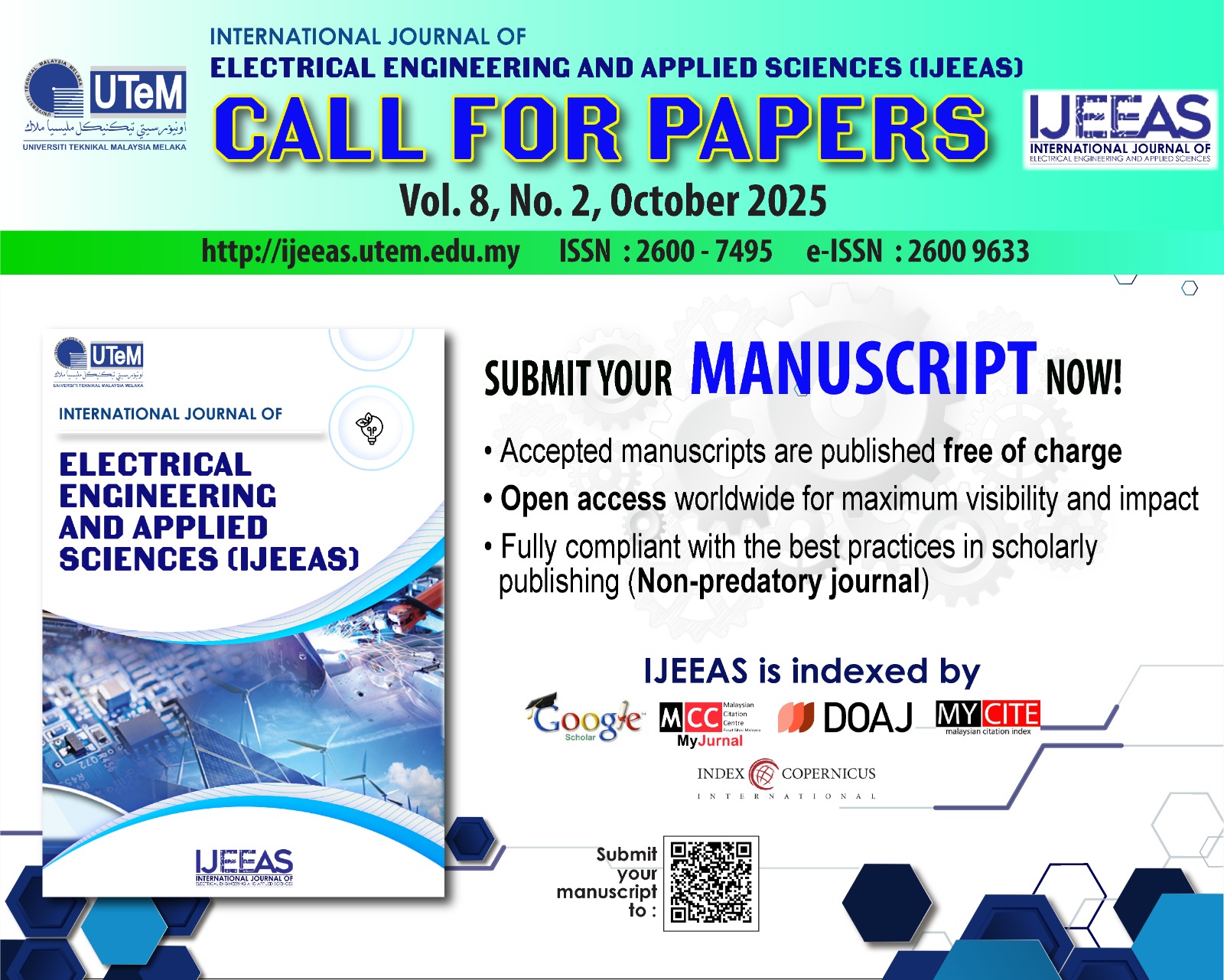Output Power Forecasting for 2kW Monocrystalline PV System using Response Surface Methodology
Abstract
Photovoltaic (PV) system is a renewable energy source that not only able to reduce the effect of greenhouse gas towards the environment, but also a highly profitable industry nowadays. To determine the Return of Investment (ROI) of a newly installed system, forecasting is crucial. Thus, the purpose of this study is to produce a prediction model for the yearly output power of the PV system using three environmental elements; irradiance, module temperature and ambient temperature by Response Surface Methodology (RSM). To do so, MATLAB RStool which is consisting of four models; multiple linear regression (MLR), interaction, pure quadratic, and full quadratic is used. The 5 minute sampling size of yearly 2014 weather station data the three environmental elements and output power of a 2kW Monocrystalline real PV system are used for training. Whereas, yearly 2015 data of the aforementioned elements are used for validation. The coefficient of determination (R2) method and root mean square error (RMSE) approach were used to determine the most accurate prediction model. Results show that, full quadratic is the most accurate prediction model with R2 value of 0.9995 and RMSE of 8%. It is hoped that the prediction model introduced can be a viable method to be used by the PV system installer.
Downloads
References
M. Almaktar, H.A. Rahman, M.Y. Hassan and W.Z.W Omar, Photovoltaic technology in Malaysia : past, present and future plan, International Journal of sustainable Energy, Vol. 34 (No. 2): pp. 128-140, December 2014.
Tenaga Nasional, Malaysia’s Largest LSS Energised. Available at:https://www.tnb.com.my/announcements/malaysias-largest-lss -energised [Accessed on 15 January 2019].
H.A Bekhet and N.H. Harun, Role of Non-Renewable and Renewable Energy for Sustainable Electricity Generation in Malaysia, International Journal of Environmental and Ecological Engineering, Vol. 10 (No. 9): pp. 907-916, 2016
Sustainable Energy Development Authority (SEDA) Malaysia, SEDA 2015 Annual Report, 2015, SEDA 2015 Annual Report. pdf.
Sustainable Energy Development Authority (SEDA) Malaysia, SEDA 2017 Annual Report, 2017, SEDA 2017 Annual Report. pdf.
A.Y. Azman, A. A. Rahman, N.A. Bakar, F. Hanaffi and A. Khamis, Study of Renewable Energy Potential in Malaysia, IEEE First Conference on Clean Energy and Technology CET, pp. 170-176, 2011
D.P Larson, N. Lukas and F.MC. Carlos, Day-ahead forecasting of solar power output from photovoltaic plants in the American Southwest, Renewable Energy Elsevier Ltd, Vol. 91, pp. 11-20, 2016.
D.P. Larson, L. Nonnenmacher and C.F.M. Coimbra, Forecasting Power Output of Solar Photovoltaic System Using Wavelet Transform and Artificial Intelligence Techniques, Elsevier B.V Selection, Vol. 12, pp. 332-337, 2012.
M. Ghofrani and M.Alolayan, Time Series and Renewable Energy Forecasting, IntechOpen, pp. 78-92, 20th December 2017.
Y. Li, Y. Su and L. Shu, An ARMAX model for forecasting the power output of a grid connected photovoltaic system, Elsevier B.V Selection, Vol. 66, pp. 78-89, 2014.
R.R.N. Rajan, R. Rajesh and M.R Elayidom, Optimization of Production of Transesterified Jatropha Curcas oil using Response Surface Methodology, IEEE, pp. 187-193, 2016.
A. Kasa, Z. Chik and M.R. Taha, Global Stability of segmental Retaining Wall Reinforced with Geogrid, Online Journal of Science and Technology, Vol. 2 (Issue 4), 41-46, October 2012.
N. Anuar, A.F.M. Adnan, N. Saat, N. Aziz and R.M. Taha, Optimization of Extraction Parameters by Using Response Surface Methodology, Purification, and Identification of Anthocyanin Pigments in Melastoma malabathricum Fruit, The Scientific World Journal, 1- 10, 2013.
A. Yang, Y. Han, Y. Pan, H. Xing and J. Li, Optimum surface roughness prediction for titanium ally by adopting response surface mrthodology, Elsevier B.V results in physics, Vol. 7, pp. 1046-1050, 2017.
N.V. Suc and N.T.C. Tu, Optimizing U(VI) adsorption onto microwave activated rice husk ash through response surface methdology, IEEE 3rd International Conference on Green Technology and Sustainable Development, pp. 251-257, 2016.
IEC 61724: 1998, Photovoltaic System Performance- Guidelines for Measurement, Data Exchange and Analysis (BSi, 1998).
Operation and Maintenance Manual, Kipp & Zonen: Instruction Manual CM11 and CM14 Pyranometer/ Albedometer (Innotech Synergy Sdn. Bhd, 2012, pp. 13-20).
J. Copper, A. Bruce, T. Spooner, M. Calais, T. Pryor and M. Watt, Australian Technical Guidelines for Monitoring and Analysing Photovoltaic Systems, The Australian Photovoltaic Institute (APVI), (Version 1), pp. 7, November 2013.
Downloads
Published
How to Cite
Issue
Section
License
Authors who publish with this journal agree to the following terms:
- Authors retain copyright and grant the journal right of first publication with the work simultaneously licensed under a Creative Commons Attribution License that allows others to share the work with an acknowledgement of the work's authorship and initial publication in this journal.
- Authors are able to enter into separate, additional contractual arrangements for the non-exclusive distribution of the journal's published version of the work (e.g., post it to an institutional repository or publish it in a book), with an acknowledgement of its initial publication in this journal.
- Authors are permitted and encouraged to post their work online (e.g., in institutional repositories or on their website) prior to and during the submission process, as it can lead to productive exchanges, as well as earlier and greater citation of published work (See The Effect of Open Access).







